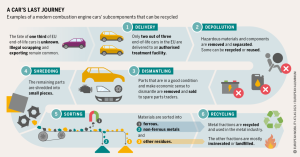Lesson 2 – End-of-Life Vehicles (ELVs)
Welcome to second lesson of our online course on end-of-life vehicle recycling operations and environmental challenges. In this course, we will explore a variety of phases required to recycle end-of-life vehicles that allow the restoration of large quantities of metals and component parts for remanufacturing.
VEHICLES at the ELV’s, are automotive products that have reached the end of their useful life, that is, they can no longer drive on public roads. End-of-life vehicles generate around 7-8 million tonnes of waste every year in the EU. Their components are now considered waste and can only be thrown away or used for recycling. Thus, ELVs can also be called “unwanted vehicles” or “aged vehicles”, being produced from two causes: natural “old” and premature “accidents”.
When ELVs are not managed properly, they can cause environmental problems, wasting millions of tons of materials. The life cycle of ELVs includes all the necessary steps from the design phase, vehicle manufacturing, operation and maintenance of the vehicle throughout its life, to scrapping and recycling.
Regardless of its age and weight, a vehicle is mostly made of about 75% metal, both ferrous and non-ferrous, while the remaining 25% of the vehicle’s weight comes from tires, plastic, rubber, plastic, gases, glass , fabrics, fluids such as oil, antifreeze, lubricants and gasoline/diesel, as well as various electronic components/circuits containing heavy metals and rare metals.
End-of-life vehicle recycling involves the processing and preparation of used vehicles for disposal, which requires six different activities as shown in the following figure:
A car’s last journey [sursa:https://ec.europa.eu/environment/waste/pdf/WASTE%20BROCHURE.pdf]
The first step in processing a used vehicle is to remove the battery and drain all hazardous fluids, such as those from fuel tanks, transmissions, radiators and power steering units, to ensure the safe removal of all components for recycling.
In conclusion, more than 80% of the weight of the entire vehicle is reused, re-manufactured or recycled.
